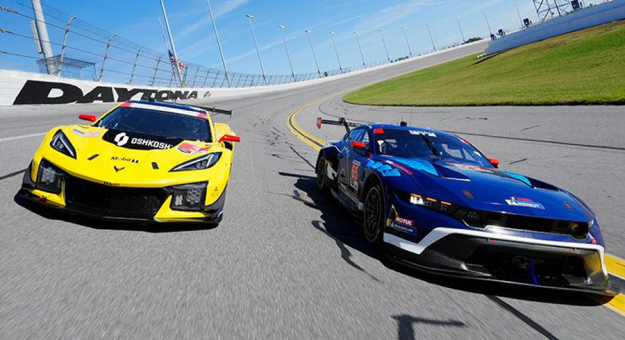DAYTONA BEACH, Fla. — As the sportiest cars in the Chevrolet and Ford lineups, it was inevitable that the Corvette and Mustang would soon show up at racetracks across America. Here’s a brief look at the competition history of two iconic nameplates.
CORVETTE
The Corvette’s introduction in 1953 coincided with a post-war sports car boom that spurred the construction of several notable permanent road courses around the country, including Road America, Lime Rock Park, Watkins Glen International, VIRginia International Raceway and WeatherTech Raceway Laguna Seca.
Chevrolet General Manager Ed Cole and chief engineer Zora Arkus-Duntov were huge proponents of using racing to develop the Corvette’s capabilities and grow its appeal. By 1957, the production car had gained a V-8 engine and four-speed manual transmission, and it became a popular choice for racers, taking class victories at the Twelve Hours of Sebring in three of the next four years.
In 1960, Briggs Cunningham took a trio of Corvettes to the 24 Hours of Le Mans, with the lead car winning its class and finishing eighth overall. Meanwhile back at home, a GM prototype called the Sting Ray was winning consecutive SCCA championships and providing clues about how the upcoming C2 version of the production car would look. The peak racing C2 Corvette was the Jim Hall’s Grand Sport, which briefly led at Sebring in 1964 with future racing team owner/auto industry titan Roger Penske at the wheel.
When the C3 generation Corvette debuted in 1968, one of the first racing efforts was fielded by actor James Garner of “The Rockford Files” and “Grand Prix” fame. The C3 enjoyed competition success all around the world, dominating SCCA production racing and scoring numerous class wins in the classic American endurance races at Daytona and Sebring. The C3 Corvette’s pinnacle was a series of increasingly wild IMSA racers built by John Greenwood with design input from Bob Riley.
Corvette’s mastery of SCCA racing continued after the introduction of the C4 in 1984. Meanwhile, Chevrolet worked with Lola to build a prototype for IMSA’s original Grand Touring Prototype (GTP) class. This car ran from 1984-88, with a car prepared by Hendrick Motorsports taking two race wins. The Corvette name reappeared in IMSA’s Daytona Prototype (DP) class from 2012-16, a very lucrative run that took 36 wins from 56 starts.
The familiar yellow livery of Corvette Racing appeared in 1999, starting a 25-year era in which the factory team developed C5, C6, C7, and C8 Corvettes into a world beater, earning many class championships and race wins as recently as this year, when Ben Keating, Nicky Catsburg and Nico Varrone took the LM GTE class win at Le Mans and went on to claim the season title in the FIA World Endurance Championship.
For 2024, Chevrolet is making available the Corvette Z06 GT3.R to customer teams; Pratt Miller Motorsports will field two cars in the Grand Touring Daytona Pro (GTD PRO) class and AWA has a pair set for the Grand Touring Daytona (GTD) class of the IMSA WeatherTech SportsCar Championship.
MUSTANG
The Ford Mustang hit the racetrack within weeks of its April 1964 release. Holman + Moody, famous for its exploits in NASCAR, built the V-8 engines for a trio of Mustangs that Alan Mann Racing campaigned in the Automobile Tour de France, a 4,000-mile road rally that included 17 “Speed Stages.” The Mustangs finished 1-2 in the 3-liter Touring class. Holman + Moody was also instrumental in developing the early Mustang into a Funny Car for National Hot Rod Association drag racing competition.
Like Holman + Moody, Carroll Shelby’s Shelby American team was involved in Ford’s successful prototype program that produced major sports car victories at Daytona, Sebring and Le Mans. Shelby also developed the 1965 Mustang GT350R, which quickly tasted success in the club and pro racing ranks with the SCCA and IMSA’s predecessors. The SCCA’s premier pro Trans-Am series peaked in 1970, when Bud Moore-prepared Mustangs driven by Parnelli Jones and George Follmer took on Detroit’s Pony Car competition and clinched the championship for Ford.
The next notable racing Mustang was the 1975 Kemp Cobra II, a rulebook-bending custom that caused IMSA to create a new class called GTX. Bob Riley, who went on to design the dominant Riley & Scott Mk II prototype in the 1990s, was the “pencil” behind the Kemp car.
Riley was then part of a collaboration between Roush and Zakspeed that produced the front-engine Mustang GTP in 1983. Riley’s involvement with Roush concluded with the design of the Roush Racing Mustangs that were part of Roush’s 10 consecutive class victories in the Rolex 24 and Daytona events in which they competed. (Photo: Ford Performance)
Mustang remains the Ford body of choice in drag racing, and since 2019, the Mustang is the basis for Ford’s entries in the NASCAR Cup and Xfinity series. Team Penske has won the last two Cup Series championships using Mustangs, with drivers Joey Logano and Ryan Blaney.
Ford has offered a turnkey Mustang GT4 racing car developed by Multimatic since 2016 that is a regular race winner in the Grand Sport (GS) class of the IMSA Michelin Pilot Challenge. For 2024, the racing Mustang stable will expand to include the Multimatic-prepped Mustang GT3, which is eligible for the GTD PRO and GTD classes of the WeatherTech Championship.
Direct competition in the same class between Mustang and Corvette has been relatively rare over the years. Especially in GTD PRO, it’s likely to be a highlight of the 2024 IMSA season.
